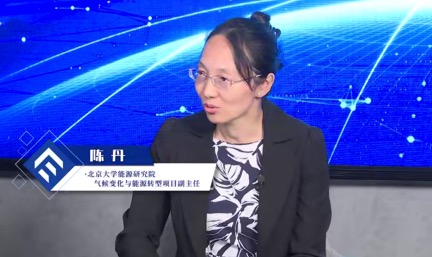Chen Dan
Source:中国能源模型论坛(CEMF)
Jun 05, 2023
On June 5, 2023, World Environment Day, the fourth installment of the China Energy Modeling Forum (CEMF) Salon Series focuses on "Multi-level pollution reduction and carbon reduction, exploring synergistic innovation paths". The following is the viewpoint of Chen Dan, Deputy Director of Climate Change and Energy Transition Program, Energy Research Institute of Peking University.
Theoretically, what are the new contents of pollution and carbon reduction in academia?

Dr. Chen Dan, Associate Director of the Climate Change and Energy Transition Program at Peking
University's Energy Research Institute, noted that the scientific community is actively working on the issue of carbon reduction, aiming to assess past achievements and provide better direction for future pathways. In terms of historical assessment, there has been a significant reduction in the amount of CO2 emissions in China through the adoption of a number of governance measures. According to statistics, from 2013 to 2020, the cumulative reduction of carbon dioxide emissions reached 2.43 billion tons, accounting for 3.1% of the cumulative carbon dioxide emissions in the same period. This shows that China has achieved remarkable results in carbon reduction. However, according to the latest research by several teams, the space for pollutant reduction in China is gradually narrowing, and it is increasingly difficult to reduce emissions by end-of-pipe management. Therefore, from the perspective of scientific theory, more attention needs to be paid to the adjustment of energy structure and the improvement of the overall system. The future also faces daunting challenges and tasks. According to the current ratio of autonomous contributions and PM2.5 management targets for key regions, it is expected that China can achieve an annual average of 35 micrograms per cubic meter by 2030. However, if further improvements in air quality are desired, for example to reach the World Health Organization standard of 10 micrograms per cubic meter, it will be necessary to get closer to the 2-degree or carbon-neutral target, and even further to reach the 1.5-degree target achievement. Both for the historical assessment and the future outlook, the adjustment of the energy system and the overall system is what China needs to work on. The previous work on pollution and carbon reduction mainly emphasized the management of PM2.5. In the future, China will also face more challenges such as the synergistic management of PM2.5, ozone and carbon dioxide, which will require more efforts and practices from the academic community.
Where might the greatest difficulties lie in promoting synergies between pollution reduction and carbon reduction? What are the key issues that need to be broken through?
According to Chen Dan, China now needs to expand synergies from outcome-oriented to system-wide design, and in doing so, there are many trade-offs to be resolved, such as balancing economy, safety and cleanliness in the energy system. In addition, different regions face different pressures for energy transition and environmental goals, with the western region facing serious challenges as an important coal base, where low-carbon energy transition is difficult, synergistic economic growth is even more difficult, and water resources constraints may be imposed. Taken as a whole, it is necessary to strike a balance between various aspects and think systematically from a holistic perspective. It is worth noting that pollution and carbon reduction is not just about cutting traditional pollutants, but should be considered in the context of a larger ecosystem, with a more holistic perspective and more constraints.
What are the challenges to reducing pollution and carbon emissions in the context of economic recovery and the new international situation?
According to Chen Dan, in today's changing energy landscape and climate governance environment, a number of factors may affect China's choices on the path to reduce pollution and carbon emissions, but all in all, the opportunities outweigh the challenges. China needs to think about how to respond to and change the current landscape, and self-improvement is the end of all roads. In the long run, China needs to be competitive in international competition, especially in resource utilization and green energy industry. It should seize the favorable opportunity to promote the progress of pollution reduction and carbon reduction, and even under the pressure of European and American bills and policies, it should make the cost advantageous through the large-scale application of renewable energy, and build up China's international discourse power under the international discourse system that the value of carbon is gradually increasing.
What is the way forward for the synergization of pollution and carbon reduction?
According to Chen Dan, the atmospheric environment is a complex system that needs to be studied using a systematic methodology and provide a holistic library of tools to provide an optimized approach to pollution reduction and carbon reduction from both policy and practice perspectives. In terms of regions, not only should we pay attention to the key regions in the east, but also the west, energy-importing, energy-exporting, and resource-exhausting cities need to look for suitable paths to reduce pollution and carbon emissions, and to design programs that harmonize the paths of pollution reduction and economic development, so as to form some replicable and generalizable experiences. At the same time, policies should be used to address cost issues, such as internalizing carbon dioxide costs or using low-cost renewable energy.

